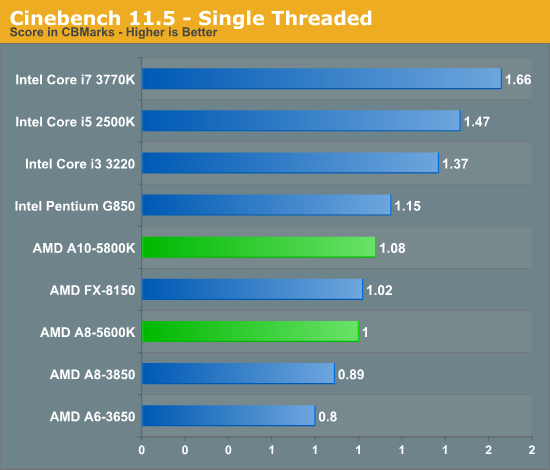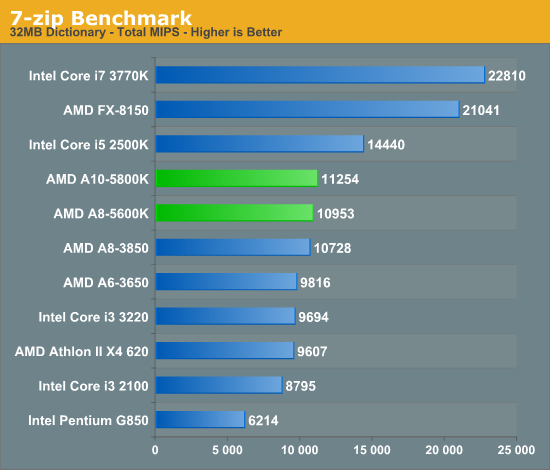AMD A10-5800K & A8-5600K Review: Trinity on the Desktop, Part 2
by Anand Lal Shimpi on October 2, 2012 1:45 AM ESTTrinity CPU Performance: The Good and the Bad
We're going to start our performance investigation a little out of order. The big question on everyone's mind is how much single threaded performance has improved over Bulldozer, and whether it's enough to actually make Trinity faster than Llano across the board. We'll use Cinebench 11.5 as it has both single and multithreaded test options:

The good news is that single threaded performance is definitely up compared to Llano. Piledriver likely has some to do with this, but so does the fact that the A10 can run at up to 4.2GHz (~4GHz typically) with one of its cores active compared to the 2.9GHz clock speed of the A8-3850. Compared to the Bulldozer based FX-8150 there's a slight (~6%) increase in single threaded performance. Although I don't expect anyone will be cross shopping a Trinity APU and a FX CPU, it's important to keep an eye on progress here as we'll eventually get a high-end quad-module/eight-core Piledriver CPU.
Note that compared to even previous generation, low-end Intel CPUs without turbo there's a huge gap in single threaded performance. If we look at the gap AMD has to make up vs. Ivy Bridge it's not pretty. Intel's Core i3 3220 manages a 27% performance advantage over the A10-5800K. Even if Steamroller is able to deliver a 15% increase in performance at the same clock speed, there will still be a gap. And we're not even talking about how Haswell will grow this gap. For the foreseeable future I don't see AMD closing the single threaded performance gap. Jim Keller's job is to fix this problem, but it'll probably take 2 - 3 years to get there.

The multithreaded test shows the other end of reality: in heavily threaded foating point workloads it's possible that we'll see a regression compared to Llano. Remember the Bulldozer/Piledriver architecture prioritizes integer over floating point performance. Truth be told this regression is pretty rare in our tests, but until we get to Steamroller we will still see these types of situations.
Throw more threads at the problem and even with a floating point workload Intel can't pull ahead however. The A10 offers similar performance to the Core i3 3220 at a lower price. Your decision here would come down to the rest of the factors: single threaded performance, processor graphics performance, overclocking capabilities and power consumption. Intel and AMD both win two of those each, it's really a matter of what matters most to you.
A heavily threaded FP workload doesn't really play to AMD's advantages though, what happens when you get a heavily threaded integer workload however? The 7-zip benchmark gives us just that:

Here AMD manages a 16% performance advantage over the Core i3 3220. I'd even go as far as to say that Trinity would likely beat any dual-core Intel machine here. The performance advantage is somewhat artificial as Intel purposefully removes turbo from its dual-core desktop CPUs. This should be AMD's best foot forward, but once again it'll likely take Steamroller for this design to start to make sense.
Speaking of artificial product segmentation, one major feature Intel takes away when you get down to the dual-core desktop i3 level is AES-NI support. Hardware accelerated AES support is something that you get only with the more expensive Core i5/i7s. With Trinity, you get AES-NI support for the entire stack. The result is much better performance in those applications that depend on it:

Like most of the advantages we've talked about thus far, there are really very specific use cases where Trinity makes sense over a similarly priced Intel CPU.










178 Comments
View All Comments
creed3020 - Tuesday, October 2, 2012 - link
I would really appreciate it if a similar test of Trinity as what was done to Llano regarding GPU Performance vs. Memory Speed was completed (http://www.anandtech.com/show/4476/amd-a83850-revi... I am curious if the trend has remained the same, improved, or decreased.I am in the process of building a new Office PC for family whose needs are basic and Trinity fits the bill quite well, especially the A8-5500 or A6-5400K. I want to purchase memory that compliments the GPU well.
On another GPU note I find it strange that there was no test of AMD Radeon Dual Graphics (http://www.amd.com/us/products/technologies/dual-g... as that a native scaling of GPU platform for this APU, not a high end discrete GPU. The latter usage scenario just doesn't seem that common considering the target market for the APU.
Hubb1e - Tuesday, October 2, 2012 - link
Go with 1866 or 1600. 1866 is about 5% faster GPU performance if that matter much in your use case.creed3020 - Wednesday, October 3, 2012 - link
My current HTPC uses an A8-3850 with 1866 memory so I am aware of the benefits, my question is more about getting an understanding of this phenomenon with Trinity. I am curious if it was has become less important or perhaps even more so.I'm not gaming on my APU so there is no concern to squeeze every drop of FPS out of the GPU. I am more curious from a research and review standpoint.
Moizy - Tuesday, October 2, 2012 - link
Anand, you mentioned several times that Trinity holds the integrated graphics and overclockadvantage, while Intel holds the single-threaded and power consumption advantage. To me, though, the A10-5700 attempts to address the power consumption advantage by offering a lower tdp without cutting down the clocks too much (while sacrificing overclockability though).
Throwing in the A10-5700 at some point in the future, assuming you can get your hands on one, would provide an interesting comparison for those interested in Trinity's gpu and competitive power consumption.
ewilliams28 - Tuesday, October 2, 2012 - link
apologies if it's been covered but i would like to know exactly which cards work in this mode. I have heard that if you go too high they don't work together. it's my understanding that 7670 are OEM only and i can't believe that the 6670 that i can buy is still the best i can do. i plan to use 1080p since 1920x1200 has basically gone the way of the dodo bird. but i do like to crank up the settings. luckily the most complicated game i play is World of Warcraft. i will probably fold with this box though.creed3020 - Tuesday, October 2, 2012 - link
http://www.amd.com/us/products/technologies/dual-g...halbhh2 - Tuesday, October 2, 2012 - link
Overall, a Trinity laptop would do fine during idle, which *is about 85%* of what 90% of laptops do when they are on.That matters.
So, an interesting test for real-world use for *most* consumers (wife, kids, most of the people most of us know) would be a run-time battery life test for leaving the computer on, and surfing to 25 web pages, and playing a couple of modest games for 45 minutes, and then watching a streamed movie.
That would be real world use for 90% of laptops.
In view of that, for people that aren't using their laptop in a demanding way, a good question is how much does it cost, and how long does it run until you need to plug in. That's all.
jfelano - Tuesday, October 2, 2012 - link
Why does Anandtech still use 1280x1024 and 1680x1050 as their bencmarks? Is this still 2008?Beenthere - Tuesday, October 2, 2012 - link
Answer: Because most people still use these screen resolutions. This review is for a desktop APU, thus the appropriate screen resolutions.silverblue - Tuesday, October 2, 2012 - link
Hehe... you try playing anything remotely recent at a higher resolution on an IGP...